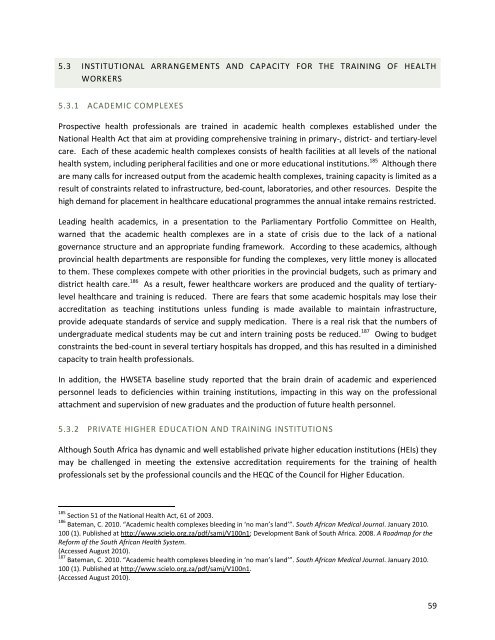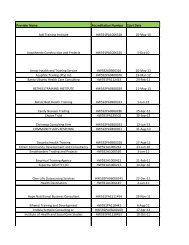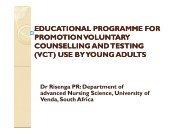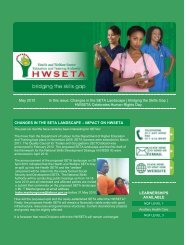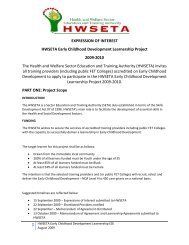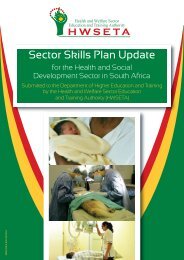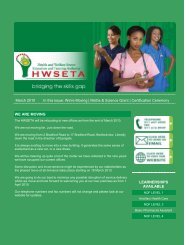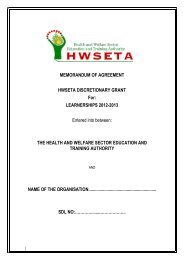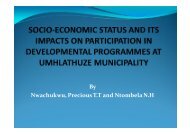sector skills plan for the health sector in south africa
sector skills plan for the health sector in south africa
sector skills plan for the health sector in south africa
Create successful ePaper yourself
Turn your PDF publications into a flip-book with our unique Google optimized e-Paper software.
5.3 INSTITUTIONAL ARRANGEMENTS AND CAPACITY FOR THE TRAINING OF HEALTH<br />
WORKERS<br />
5.3.1 ACADEMIC COMPLEXES<br />
Prospective <strong>health</strong> professionals are tra<strong>in</strong>ed <strong>in</strong> academic <strong>health</strong> complexes established under <strong>the</strong><br />
National Health Act that aim at provid<strong>in</strong>g comprehensive tra<strong>in</strong><strong>in</strong>g <strong>in</strong> primary-, district- and tertiary-level<br />
care. Each of <strong>the</strong>se academic <strong>health</strong> complexes consists of <strong>health</strong> facilities at all levels of <strong>the</strong> national<br />
<strong>health</strong> system, <strong>in</strong>clud<strong>in</strong>g peripheral facilities and one or more educational <strong>in</strong>stitutions. 185 Although <strong>the</strong>re<br />
are many calls <strong>for</strong> <strong>in</strong>creased output from <strong>the</strong> academic <strong>health</strong> complexes, tra<strong>in</strong><strong>in</strong>g capacity is limited as a<br />
result of constra<strong>in</strong>ts related to <strong>in</strong>frastructure, bed-count, laboratories, and o<strong>the</strong>r resources. Despite <strong>the</strong><br />
high demand <strong>for</strong> placement <strong>in</strong> <strong>health</strong>care educational programmes <strong>the</strong> annual <strong>in</strong>take rema<strong>in</strong>s restricted.<br />
Lead<strong>in</strong>g <strong>health</strong> academics, <strong>in</strong> a presentation to <strong>the</strong> Parliamentary Portfolio Committee on Health,<br />
warned that <strong>the</strong> academic <strong>health</strong> complexes are <strong>in</strong> a state of crisis due to <strong>the</strong> lack of a national<br />
governance structure and an appropriate fund<strong>in</strong>g framework. Accord<strong>in</strong>g to <strong>the</strong>se academics, although<br />
prov<strong>in</strong>cial <strong>health</strong> departments are responsible <strong>for</strong> fund<strong>in</strong>g <strong>the</strong> complexes, very little money is allocated<br />
to <strong>the</strong>m. These complexes compete with o<strong>the</strong>r priorities <strong>in</strong> <strong>the</strong> prov<strong>in</strong>cial budgets, such as primary and<br />
district <strong>health</strong> care. 186 As a result, fewer <strong>health</strong>care workers are produced and <strong>the</strong> quality of tertiarylevel<br />
<strong>health</strong>care and tra<strong>in</strong><strong>in</strong>g is reduced. There are fears that some academic hospitals may lose <strong>the</strong>ir<br />
accreditation as teach<strong>in</strong>g <strong>in</strong>stitutions unless fund<strong>in</strong>g is made available to ma<strong>in</strong>ta<strong>in</strong> <strong>in</strong>frastructure,<br />
provide adequate standards of service and supply medication. There is a real risk that <strong>the</strong> numbers of<br />
undergraduate medical students may be cut and <strong>in</strong>tern tra<strong>in</strong><strong>in</strong>g posts be reduced. 187 Ow<strong>in</strong>g to budget<br />
constra<strong>in</strong>ts <strong>the</strong> bed-count <strong>in</strong> several tertiary hospitals has dropped, and this has resulted <strong>in</strong> a dim<strong>in</strong>ished<br />
capacity to tra<strong>in</strong> <strong>health</strong> professionals.<br />
In addition, <strong>the</strong> HWSETA basel<strong>in</strong>e study reported that <strong>the</strong> bra<strong>in</strong> dra<strong>in</strong> of academic and experienced<br />
personnel leads to deficiencies with<strong>in</strong> tra<strong>in</strong><strong>in</strong>g <strong>in</strong>stitutions, impact<strong>in</strong>g <strong>in</strong> this way on <strong>the</strong> professional<br />
attachment and supervision of new graduates and <strong>the</strong> production of future <strong>health</strong> personnel.<br />
5.3.2 PRIVATE HIGHER EDUCATION AND TRAINING INSTITUTIONS<br />
Although South Africa has dynamic and well established private higher education <strong>in</strong>stitutions (HEIs) <strong>the</strong>y<br />
may be challenged <strong>in</strong> meet<strong>in</strong>g <strong>the</strong> extensive accreditation requirements <strong>for</strong> <strong>the</strong> tra<strong>in</strong><strong>in</strong>g of <strong>health</strong><br />
professionals set by <strong>the</strong> professional councils and <strong>the</strong> HEQC of <strong>the</strong> Council <strong>for</strong> Higher Education.<br />
185 Section 51 of <strong>the</strong> National Health Act, 61 of 2003.<br />
186 Bateman, C. 2010. “Academic <strong>health</strong> complexes bleed<strong>in</strong>g <strong>in</strong> ‘no man’s land’”. South African Medical Journal. January 2010.<br />
100 (1). Published at http://www.scielo.org.za/pdf/samj/V100n1; Development Bank of South Africa. 2008. A Roadmap <strong>for</strong> <strong>the</strong><br />
Re<strong>for</strong>m of <strong>the</strong> South African Health System.<br />
(Accessed August 2010).<br />
187 Bateman, C. 2010. “Academic <strong>health</strong> complexes bleed<strong>in</strong>g <strong>in</strong> ‘no man’s land’”. South African Medical Journal. January 2010.<br />
100 (1). Published at http://www.scielo.org.za/pdf/samj/V100n1.<br />
(Accessed August 2010).<br />
59


